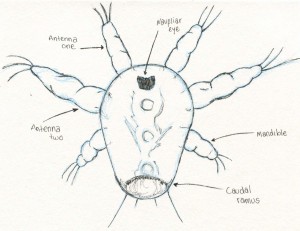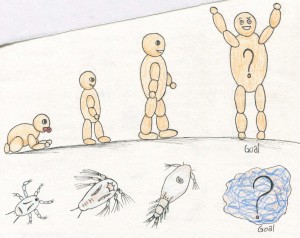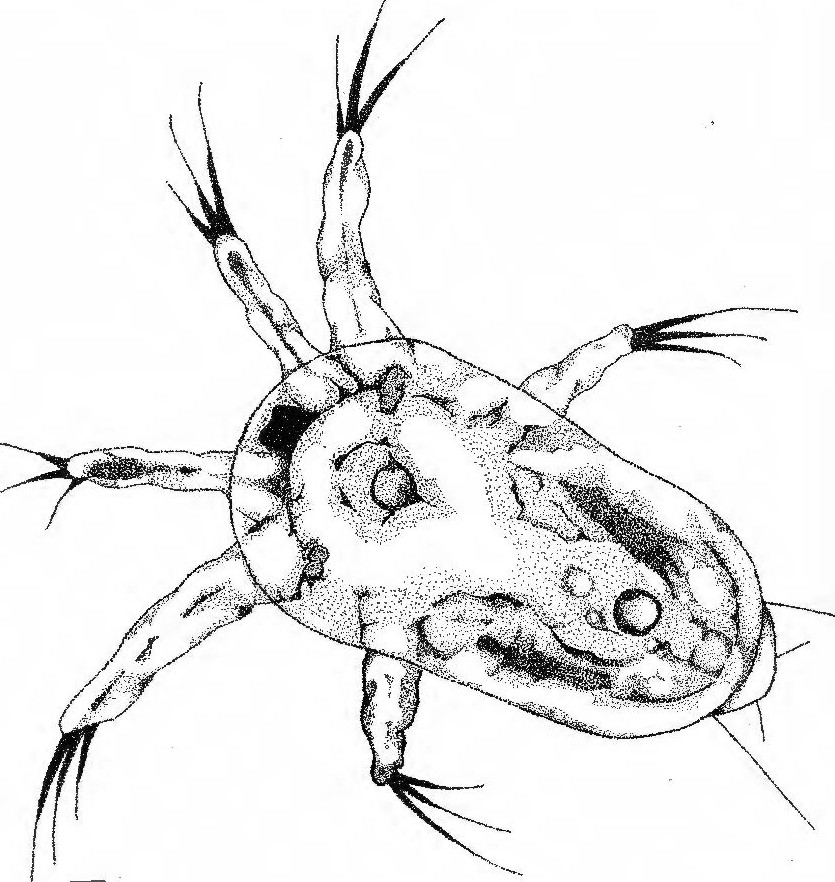Author: Iris Paz
General Information
The Nauplius larva is the first planktonic larval form of most marine and of some freshwater crustaceans, from barnacles to anostracans to decapods. Crustaceans may pass through a number of larval and immature stages between hatching from their eggs and reaching their adult form.  Even so, many groups have bypassed this phase during their development. The larva bears little resemblance to the adult, and there are sometimes where is not known what larva will grow into what adult. A nauplius (plural nauplii) is the first larva of animals, classified as crustaceans. Nauplius larvae belong to the phylum Arthropod.
Even so, many groups have bypassed this phase during their development. The larva bears little resemblance to the adult, and there are sometimes where is not known what larva will grow into what adult. A nauplius (plural nauplii) is the first larva of animals, classified as crustaceans. Nauplius larvae belong to the phylum Arthropod.
It body consists of a thorax and abdomen, head and telson*1.
This organism has a single, median eye at the front of its head. This eye is referred to as the Nauplius eye or “naupliar eye”, and is often absent in later developmental stages, but can be retained into the adult form in some groups, such as the Notostraca*2.
With only three pairs of appendages, the first and second function as antennae, and the third function as mandibles; the antennae and mandible bear swimming setae which is a stiff, hair-like structure (A Dictionary of Zoology (4 ed.)). These appendages are usually feeding limbs and also aid in propulsion.
The body of the Nauplius shows no external sings of segmentation. During subsequent molts, the body adds new segments posteriorly, and new appendages that appear like buds. A shield covers the naupliar body in the earlier stages. At the posterior end of the body there are indications of caudal rami*3 in later stages. The labrum*4 originates as a lobate flap near the frontal margin of the head, between the bases of the first antennae, and extends posteriorly along the ventral surface of the body.
| The short video shows the nauplii larva feeding behavior and its interaction with another nauplii larva. It starts with slow movements as it feeds, and then makes fast movements as it moves around. |
Nauplii symbolically represented in the 21st Century
To the 21st century the nauplius larva could symbolically represents the action of “growing up or becoming an adult”. The nauplius larva goes through several growing stages in which they molt and change the shape of its body; this growing process takes place multiple times until they become “adults”.  This is no different from humans; but humans don’t change their shape (much) nor molt. Humans grow by learning and time, from babies to child to teenager to “adult”; they might not now what they will become in the future but as times goes by they eventually become an adult.
This is no different from humans; but humans don’t change their shape (much) nor molt. Humans grow by learning and time, from babies to child to teenager to “adult”; they might not now what they will become in the future but as times goes by they eventually become an adult.
Glossary
|
1 |
Telson |
The last segment in the abdomen, or a terminal appendage to it, in crustaceans, and embryonic insects. |
|
2 |
Notostraca |
An order of small freshwater crustaceans having a shield-shaped carapace |
|
3 |
Caudal rami
|
The caudal ramus (plural: caudal rami) is a characteristic feature of primitive crustaceans. Located on the anal somite (telson segment), the caudal ramus is a pair of appendage-like or spine-like protrusions. |
|
4 |
Labrum |
A structure corresponding to a lip, especially the upper border of the mouthparts of a crustacean or insect. |
Sources Cited
- Allaby, Michael. “Nauplius Larva.” Nauplius Larva – Oxford Reference. Oxford University Press, 2014. Web. 18 May 2016. <http://www.oxfordreference.com/view/10.1093/acref/9780199684274.001.0001/acref-9780199684274-e-5762?rskey=pcSLFO&result=1>.
- Fornshell, John A., Hans-U Dahms, and Ben J. Fornshell. “Key for the Identification of Crustacean Nauplii.” Key for the Identification of Crustacean Nauplii. Sciencedirect, 2005. Web. 18 May 2016. <http://www.sciencedirect.com/science/article/pii/S1439609205000760>.
- “”Nauplius (larva)” on Revolvy.com.” Nauplius (larva). Revolvy.com, n.d. Web. 16 May 2016. http://broom03.revolvy.com/main/index.php?s=Nauplius+%28larva%29&item_type=topic
- “Nauplius.”: Nauplii, Larva, First Larva of Animals. Allthesea.com, n.d. Web. 19 May 2016. <http://www.allthesea.com/Deep-Sea-Fish-Nauplius.html>.








